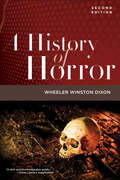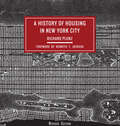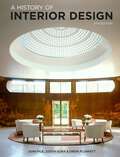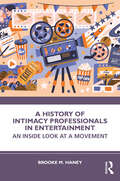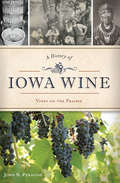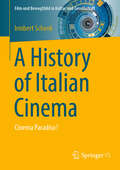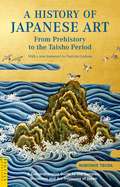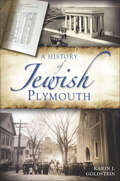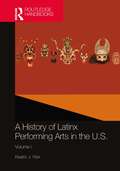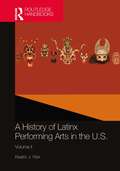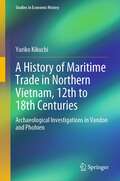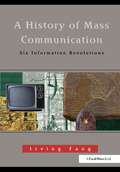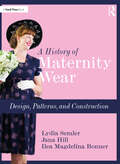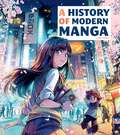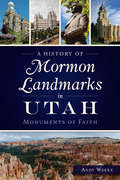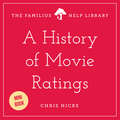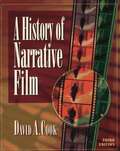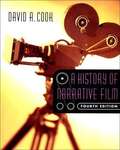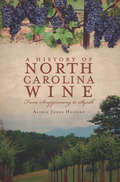- Table View
- List View
A History of Horror, 2nd Edition
by Wheeler Winston DixonEver since horror leapt from popular fiction to the silver screen in the late 1890s, viewers have experienced fear and pleasure in exquisite combination. Wheeler Winston Dixon's fully revised and updated A History of Horror is still the only book to offer a comprehensive survey of this ever-popular film genre. Arranged by decades, with outliers and franchise films overlapping some years, this one-stop sourcebook unearths the historical origins of characters such as Dracula, Frankenstein, and the Wolfman and their various incarnations in film from the silent era to comedic sequels. In covering the last decade, this new edition includes coverage of the resurgence of the genre, covering the swath of new groundbreaking horror films directed by women, Black and queer horror films, and a new international wave in body horror films. A History of Horror explores how the horror film fits into the Hollywood studio system, how the distribution and exhibition of horror films have changed in a post-COVID world, and how its enormous success in American and European culture expanded globally over time. Dixon examines key periods in the horror film-in which the basic precepts of the genre were established, then banished into conveniently reliable and malleable forms, and then, after collapsing into parody, rose again and again to create new levels of intensity and menace. A History of Horror, supported by rare stills from classic films, brings over sixty timeless horror films into frightfully clear focus, zooms in on today's top horror Web sites, and champions the stars, directors, and subgenres that make the horror film so exciting and popular with contemporary audiences.
A History of Housing in New York City
by Kenneth T. Jackson Richard PlunzSince its emergence in the mid-nineteenth century as the nation's "metropolis," New York has faced the most challenging housing problems of any American city, but it has also led the nation in innovation and reform. The horrors of the tenement were perfected in New York at the same time that the very rich were building palaces along Fifth Avenue; public housing for the poor originated in New York, as did government subsidies for middle-class housing.A standard in the field since its publication in 1992, A History of Housing in New York City traces New York's housing development from 1850 to the present in text and profuse illustrations. Richard Plunz explores the housing of all classes, with comparative discussion of the development of types ranging from the single-family house to the high-rise apartment tower. His analysis is placed within the context of the broader political and cultural development of New York City. This revised edition extends the scope of the book into the city's recent history, adding three decades to the study, covering the recent housing bubble crisis, the rebound and gentrification of the five boroughs, and the ecological issues facing the next generation of New Yorkers. More than 300 illustrations are integrated throughout the text, depicting housing plans, neighborhood changes, and city architecture over the past 130 years. This new edition also features a foreword by the distinguished urban historian Kenneth T. Jackson.
A History of Housing in New York City (Columbia History of Urban Life)
by Richard PlunzSince its emergence in the mid-nineteenth century as the nation's "metropolis," New York has faced the most challenging housing problems of any American city, but it has also led the nation in innovation and reform. The horrors of the tenement were perfected in New York at the same time that the very rich were building palaces along Fifth Avenue; public housing for the poor originated in New York, as did government subsidies for middle-class housing.A standard in the field since its publication in 1992, A History of Housing in New York City traces New York's housing development from 1850 to the present in text and profuse illustrations. Richard Plunz explores the housing of all classes, with comparative discussion of the development of types ranging from the single-family house to the high-rise apartment tower. His analysis is placed within the context of the broader political and cultural development of New York City. This revised edition extends the scope of the book into the city's recent history, adding three decades to the study, covering the recent housing bubble crisis, the rebound and gentrification of the five boroughs, and the ecological issues facing the next generation of New Yorkers. More than 300 illustrations are integrated throughout the text, depicting housing plans, neighborhood changes, and city architecture over the past 130 years. This new edition also features a foreword by the distinguished urban historian Kenneth T. Jackson.
A History of Interior Design
by Judith Gura John Pile Drew PlunkettA History of Interior Design tells the story of 6,000 years of domestic and public space. It’s an essential resource for students, professionals, and anyone interested in interior design, the decorative arts, architecture, and art history. It explores a broad range of styles and movements, weaving together a fascinating narrative from cave dwellings and temple architecture, through Gothic cathedrals and Islamic palaces, to modern skyscrapers and the retail spaces of the 21st-century. This fully updated fifth edition includes: More on the contributions of women designers and architects Additional coverage of furniture, product design, and decoration Numerous new examples of diverse modern styles from around the world Over 700 images, more than 300 of which are new or color replacements for black and white photos An extra final chapter focusing on the influence of the latest technology and current thinking on the importance of conservation and ethical sourcing
A History of Interior Design Fifth Edition
by Judith Gura John Pile Drew PileA History of Interior Design tells the story of 6,000 years of domestic and public space. It's an essential resource for students, professionals and anyone interested in interior design, the decorative arts, architecture and art history. It explores a broad range of styles and movements, weaving together a fascinating narrative from cave dwellings and temple architecture, through Gothic cathedrals and Islamic palaces, to modern skyscrapers and the retail spaces of the 21st-century.This fully updated fifth edition includes more on the contributions of women designers and architects, additional coverage of furniture, product design and decoration, as well as numerous examples of diverse modern styles from around the world. An extra final chapter focuses on the influence of the latest technology and current thinking on the importance of conservation and ethical sourcing.This new edition includes 730 images, over 300 of which are new or colour replacements for black and white photos.
A History of Intimacy Professionals in Entertainment: An Inside Look at a Movement
by Brooke M. HaneyA History of Intimacy Professionals in Entertainment is the first book that explores the evolution of intimacy coordinators, choreographers and directors in the performing arts, highlighting the history of their critical role in fostering safe(r) and respectful environments on set and in theaters.Readers will gain a deep understanding of the history and importance of intimacy work in the entertainment industry, as told by an insider, along with insights into the creation of best practices and protocols and the emergence of training organizations. Focused primarily on the USA, part one dives into the cultural events that impacted and galvanized the role of intimacy professionals, like TIME'S UP, #MeToo, Black Lives Matter and the Covid-19 pandemic. It also looks at how unions and the press responded to and affected the movement, as well as other communities that influenced the creation of protocols. Part two consists of interviews with global thought leaders, analysis and resources. A love letter to the intimacy industry, A History of Intimacy Professionals in Entertainment is meant for producers, directors, actors, educators, students in performing arts programs and anyone who advocates for safer practices in entertainment. Intimacy professionals will also greatly benefit from having the knowledge of how we got here recorded.
A History of Iowa Wine: Vines on the Prairie (American Palate)
by John N. PeragineIowa has a history with grapevines that goes back more than a century. New York lawyer Hiram Barney obtained a tract of land in southeast Iowa as part of the Half-Breed program following the American Indian Wars and created the White Elk Winery. German settlers in Amana tended community vineyards for communal wines. Before Prohibition, the Council Bluffs Grape Growers Association grew grapes and shipped them eastward by the ton. In the early 1900s, the state was among the nation's top producers of grapes. Pesticides, weather and government subsidies ended the time of the vines of the prairie until their recent return. Author John N. Peragine details the rise, fall and resurgence of the industry in the Hawkeye State.
A History of Italian Cinema: Cinema Paradiso? (Film und Bewegtbild in Kultur und Gesellschaft)
by Irmbert SchenkThis book provides a complete description of the development of Italian film and cinema from its beginnings in 1895 until today. Special emphasis is placed on those periods in which Italian film history became aesthetically decisive for world cinematography: silent film of the 1910s, neorealism after World War II, and auteur and genre cinema around 1960. And then on the multifaceted development up to the present day, which still guarantees films from Italy a significant place in international cinema. The chapters are introduced with compact descriptions of Italy's political and social history and the institutional formation of film and cinema. This is the basis for the extensive examination of genres and films. The film analyses also include a look at the reception by the audiences.
A History of Japanese Art
by Noritake Tsuda Patricia GrahamA History of Japanese Artt offers readers a comprehensive view of Japanese art through Japanese eyes-a view that is the most revealing of all perspectives. At the same time, it provides readers with a guide to the places in Japan where the best and most representative creations of Japanese art are to be seen.
A History of Japanese Theatre
by Jonah SalzJapan boasts one of the world's oldest, most vibrant and most influential performance traditions. This accessible and complete history provides a comprehensive overview of Japanese theatre and its continuing global influence. Written by eminent international scholars, it spans the full range of dance-theatre genres over the past fifteen hundred years, including noh theatre, bunraku puppet theatre, kabuki theatre, shingeki modern theatre, rakugo storytelling, vanguard butoh dance and media experimentation. The first part addresses traditional genres, their historical trajectories and performance conventions. Part II covers the spectrum of new genres since Meiji (1868–), and Parts III to VI provide discussions of playwriting, architecture, Shakespeare, and interculturalism, situating Japanese elements within their global theatrical context. Beautifully illustrated with photographs and prints, this history features interviews with key modern directors, an overview of historical scholarship in English and Japanese, and a timeline. A further reading list covers a range of multimedia resources to encourage further explorations.
A History of Jewish Plymouth (American Heritage)
by Karin J. GoldsteinMany visitors flock to Plymouth, Massachusetts, each year to view the historic landing spot of the Pilgrims. Three blocks from Plymouth Rock is Congregation Beth Jacob's synagogue. For more than a century, the Jewish community of this coastal New England town has flourished. Even before the establishment of the synagogue, built in 1912-13, Plymouth's history was shaped by the Jewish culture. Many colonial New England laws were derived from the Old Testament. The grave marker of famed Governor William Bradford bears an inscription in Hebrew that reads, "The Lord is the help of my life." Historian Karin J. Goldstein reveals the lasting impact of the Jewish community on Plymouth's history and the ways in which it still informs the town's unique identity today.
A History of Latinx Performing Arts in the U.S.: Volume I
by Beatriz J. RizkA History of Latinx Performing Arts in the U.S. provides a comprehensive overview of the development of the Latinx performing arts in what is now the U.S. since the sixteenth century. This book combines theories and philosophical thought developed in a wide spectrum of disciplines—such as anthropology, sociology, gender studies, feminism, and linguistics, among others—and productions’ reviews, historical context, and political implications. Split into two volumes, these books offer interpretations and representations of a wide range of Latinxs’ lived experiences in the U.S. Volume I provides a chronological overview of the evolution of the Latinx community within the U.S., spanning from the 1500s to today, with an emphasis on the Chicano artistic renaissance initiated by Luis Valdez and the Teatro Campesino in the 1960s. Volume II continues, looking more in depth at the experiences of Latinx individuals on theatre and performance, including Miguel Piñero, Lin-Manuel Miranda, María Irene Fornés, Nilo Cruz, and John Leguizamo, as well as the important role of transnational migration in Latinx communities and identities across the U.S. A History of Latinx Performing Arts in the U.S. offers an accessible and comprehensive understanding of the field and is ideal for students, researchers, and instructors of theatre studies with an interest in the diverse and complex history of Latinx theatre and performance.
A History of Latinx Performing Arts in the U.S.: Volume II
by Beatriz J. RizkA History of Latinx Performing Arts in the U.S. provides a comprehensive overview of the development of the Latinx performing arts in what is now the U.S. since the sixteenth century. This book combines theories and philosophical thought developed in a wide spectrum of disciplines—such as anthropology, sociology, gender studies, feminism, and linguistics, among others—and productions’ reviews, historical context, and political implications. Split into two volumes, these books offer interpretations and representations of a wide range of Latinxs’ lived experiences in the U.S. Volume I provides a chronological overview of the evolution of the Latinx community within the U.S., spanning from the 1500s to today, with an emphasis on the Chicano artistic renaissance initiated by Luis Valdez and the Teatro Campesino in the 1960s. Volume II continues, looking more in depth at the experiences of Latinx individuals on theatre and performance, including Miguel Piñero, Lin-Manuel Miranda, María Irene Fornés, Nilo Cruz, and John Leguizamo, as well as the important role of transnational migration in Latinx communities and identities across the U.S. A History of Latinx Performing Arts in the U.S. offers an accessible and comprehensive understanding of the field and is ideal for students, researchers, and instructors of theatre studies with an interest in the diverse and complex history of Latinx theatre and performance.
A History of Maritime Trade in Northern Vietnam, 12th to 18th Centuries: Archaeological Investigations in Vandon and Phohien (Studies in Economic History)
by Yuriko KikuchiThis book analyzes the role of Đại Việt (Vietnam) in the maritime Asian trading network of the thirteenth through the eighteenth centuries as it systematically integrates the results of archaeological investigations. The first half of the book consolidates reports from excavations conducted at Vân Đồn and Phố Hiến, trading ports of Đại Việt, incorporating sophisticated archaeological techniques distinctive of Japan in the presentations of the data. These are accompanied by precise scale drawings, detailed classifications, and quantitative analyses of unearthed artifacts. The latter half of the book discusses the materials discovered in archaeological investigations, specifically ceramics and coins, in terms of the relations among sites and networks of production, distribution, and consumption, from a broader Asian geohistorical perspective. To this end, the diplomatic policies and trading activities of each era in Vietnam are discussed, integrating the results of archaeological investigations with studies of historical documents. Expanding beyond Vietnam, results of the archaeological investigations in other maritime Asian countries, such as Japan, Indonesia, Laos, and the Philippines, are introduced, to inform a comparative study that combines all such data from both archaeology and history in a single volume as materials for broader discussion. This book is expected to contribute to international academic discourse on the history of maritime Asia and help open a new phase of scholarly endeavor in this field.
A History of Mass Communication: Six Information Revolutions
by Irving FangThis exciting new text traces the common themes in the long and complex history of mass communication. It shows how the means of communicating grew out of their eras, how they developed, how they influenced the societies of those eras, and how they have continued to exert their influence upon subsequent generations. The book is divided into six periods which are identified as 'Information Revolutions' writing, printing, mass media, entertainment, the 'toolshed' (which we call 'home' now), and the Information Highway. In looking at the ways in which the tools of communication have influenced and been influenced by social change, A History of Mass Communication provides students of media and journalism with a strong sense of the way their chosen field affects how society functions. Providing a broad-based approach to media history, Dr. Fang encourages the reader to take a careful look at where our culture is headed through the tools we use to communicate with one another.A History of Mass Communication is not only the most current text on communication history, but also an invaluable resource for anyone interested in how methods of communication affect society.
A History of Maternity Wear: Design, Patterns, and Construction
by Lydia Semler Jana Hill Ilea Magdelina BonnerA History of Maternity Wear: Design, Patterns, and Construction explores pregnancy clothing worn throughout the decades, providing historical information, images, and patterns. Filled with photos showing extant attire, with intricate details and sample patterns that can be recreated to scale, this book examines how maternity clothes were constructed, provides historical context, and aids readers in designing their own maternity garments. Each chapter includes examples of commonly worn maternity styles from a number of regions of the English-speaking world, with information from the United States, Britain, Australia, and Canada. The book concludes with a chapter on historically accurate underpinnings from the 17th century to the present day. A History of Maternity Wear: Design, Patterns, and Construction is written for costume professionals looking to research historically accurate characters and costumes for production, as well as fashion historians and costume enthusiasts.
A History of Maternity Wear: Design, Patterns, and Construction
by Lydia Semler Jana Hill Ilea Magdelina BonnerA History of Maternity Wear: Design, Patterns, and Construction explores pregnancy clothing worn throughout the decades, providing historical information, images, and patterns.Filled with photos showing extant attire, with intricate details and sample patterns that can be recreated to scale, this book examines how maternity clothes were constructed, provides historical context, and aids readers in designing their own maternity garments. Each chapter includes examples of commonly worn maternity styles from a number of regions of the English-speaking world, with information from the United States, Britain, Australia, and Canada. The book concludes with a chapter on historically accurate underpinnings from the 17th century to the present day.A History of Maternity Wear: Design, Patterns, and Construction is written for costume professionals looking to research historically accurate characters and costumes for production, as well as fashion historians and costume enthusiasts.
A History of Modern Manga
by Insight EditionsDiscover the major events and artists who have shaped the history of modern manga, with this deluxe expanded volume.Amid reconstruction after World War II, Japan saw the emergence of modern manga, which quickly became a favorite pastime of its citizens. Over the decades, the art form bore witness to the anxieties and dreams of several generations of Japanese citizens, reflecting both dark and joyful experiences. The history of manga is inextricably linked to the social, economic, political, and cultural evolution of Japan. Essential to the daily lives of its inhabitants and to its economy, manga is one of the drivers of the international development of one of the world&’s largest economies. How did the manga market reach one billion copies annually in less than half a century? Who are the major players in this incredible expansion? Discover, over the pages and years, the major events and artists who have marked the history of modern manga in this new, updated and expanded edition. DEFINITIVE GUIDE: Beginning with the advent of modern manga in 1952, A History of Modern Manga covers the development and impact of the art form through to present day. THE ULTIMATE TRIBUTE: Discover fascinating new details about essential entries in the manga canon, including Sailor Moon, Dragon Ball, Death Note, Naruto, Berserk, and more. STUNNING VISUALS: Features original, full-color illustrations as well as artwork from the featured manga titles! PERFECT GIFT FOR MANGA FANS: A History of Modern Manga is a fantastic gift for manga enthusiasts, as well as fans of Japanese history. A MANGA HISTORICAL PERSPECTIVE: Explores the unique ways in which historical events you may already be familiar with impacted and influenced manga as we know it today.
A History of Mormon Landmarks in Utah: Monuments of Faith (Landmarks)
by Andy WeeksThe home state of The Church of Jesus Christ of Latter-day Saints is a land of rugged mountains, deep canyon lands and majestic rivers. Utah and Mormon history are entwined, as so many early followers of the faith settled the region beginning in 1847. They preserved their values and heritage in the numerous temples, forts, tabernacles and cemeteries that serve as historic sacred monuments for the modern church. Author and LDS member Andy Weeks explores the history behind the landmarks that exalt the rich, deeply rooted history of Mormonism in the Beehive State.
A History of Movie Ratings
by Chris HicksThe wire-thin line that separates movies rated PG and R has been crossed over so many times in both directions that industry observers are questioning whether the rating system carries any validity at all. Just where did this system come from? And who's been trusted with dishing out the ratings anyway? As a movie reviewer for more than thirty years, author Chris Hicks knows a thing or two about Hollywood. His masterful synopsis of CARA, the MPAA, and the mess we're in today will make you think twice before you take a film rating at face value.
A History of Narrative Film (3rd ed.)
by David A. CookThe most comprehensive and complete history of international cinema in print.
A History of Narrative Film (4th edition)
by David A. CookSuitable as both a reference and a teaching text, this volume integrates film history and aesthetics with an analysis of the technological, social, and economic contexts of world cinema. It concentrates on narrative film, excluding documentary cinema, animated cinema, and the experimental avant-garde. The fourth edition features a new chapter on computer generated imaging as well as a new section of plates illustrating the development of color film technologies. Annotation ©2004 Book News, Inc., Portland, OR (booknews.com)
A History of North Carolina Wine: From Scuppernong to Syrah (American Palate)
by Alexia Jones HelsleyTake a journey through the long and exciting history of North Carolina grapes and vines. The state's native grapes grew with a wild abandon that uniformly impressed early explorers. Wine production, however, is another story--one with peaks and valleys and switchbacks. Alexia Jones Helsley recounts a tale of promise that was long unfulfilled, of disappointments and success and of competing visions and grapes. These pages speak to those intrigued by the romance of the native muscadines, appreciative of the complex varieties of North Carolina wine and fascinated by the enduring drama of human beings and their dreams. In the Old North State, the highly acclaimed vineyards of today have deep roots in the state's past.
A History of Pain
by Michael BerryThe portrayal of historical atrocity in fiction, film, and popular culture can reveal much about the function of individual memory and the shifting status of national identity. In the context of Chinese culture, films such as Hou Hsiao-hsien's City of Sadness and Lou Ye's Summer Palace and novels such as Ye Zhaoyan's Nanjing 1937: A Love Story and Wang Xiaobo's The Golden Age collectively reimagine past horrors and give rise to new historical narratives.Michael Berry takes an innovative look at the representation of six specific historical traumas in modern Chinese history: the Musha Incident (1930); the Rape of Nanjing (1937-38); the February 28 Incident (1947); the Cultural Revolution (1966-76); Tiananmen Square (1989); and the Handover of Hong Kong (1997). He identifies two primary modes of restaging historical violence: centripetal trauma, or violence inflicted from the outside that inspires a reexamination of the Chinese nation, and centrifugal trauma, which, originating from within, inspires traumatic narratives that are projected out onto a transnational vision of global dreams and, sometimes, nightmares.These modes allow Berry to connect portrayals of mass violence to ideas of modernity and the nation. He also illuminates the relationship between historical atrocity on a national scale and the pain experienced by the individual; the function of film and literature as historical testimony; the intersection between politics and art, history and memory; and the particular advantages of modern media, which have found new means of narrating the burden of historical violence.As Chinese artists began to probe previously taboo aspects of their nation's history in the final decades of the twentieth century, they created texts that prefigured, echoed, or subverted social, political, and cultural trends. A History of Pain acknowledges the far-reaching influence of this art and addresses its profound role in shaping the public imagination and conception-as well as misconception-of modern Chinese history.
A History of Pain: Trauma in Modern Chinese Literature and Film (Global Chinese Culture)
by Michael BerryThe portrayal of historical atrocity in fiction, film, and popular culture can reveal much about the function of individual memory and the shifting status of national identity. In the context of Chinese culture, films such as Hou Hsiao-hsien's City of Sadness and Lou Ye's Summer Palace and novels such as Ye Zhaoyan's Nanjing 1937: A Love Story and Wang Xiaobo's The Golden Age collectively reimagine past horrors and give rise to new historical narratives.Michael Berry takes an innovative look at the representation of six specific historical traumas in modern Chinese history: the Musha Incident (1930); the Rape of Nanjing (1937-38); the February 28 Incident (1947); the Cultural Revolution (1966-76); Tiananmen Square (1989); and the Handover of Hong Kong (1997). He identifies two primary modes of restaging historical violence: centripetal trauma, or violence inflicted from the outside that inspires a reexamination of the Chinese nation, and centrifugal trauma, which, originating from within, inspires traumatic narratives that are projected out onto a transnational vision of global dreams and, sometimes, nightmares. These modes allow Berry to connect portrayals of mass violence to ideas of modernity and the nation. He also illuminates the relationship between historical atrocity on a national scale and the pain experienced by the individual; the function of film and literature as historical testimony; the intersection between politics and art, history and memory; and the particular advantages of modern media, which have found new means of narrating the burden of historical violence. As Chinese artists began to probe previously taboo aspects of their nation's history in the final decades of the twentieth century, they created texts that prefigured, echoed, or subverted social, political, and cultural trends. A History of Pain acknowledges the far-reaching influence of this art and addresses its profound role in shaping the public imagination and conception-as well as misconception-of modern Chinese history.
